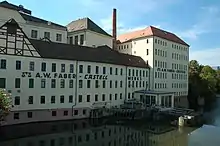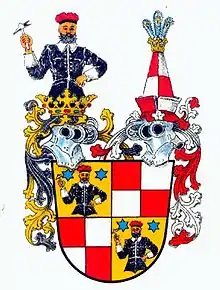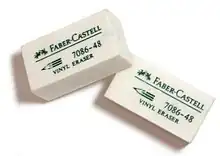Faber-Castell
Faber-Castell AG is a manufacturer of pens, pencils, other office supplies (e.g., staplers, slide rules, erasers, rulers)[1] and art supplies,[2] as well as high-end writing instruments and luxury leather goods. Headquartered in Stein, Germany, it operates 14 factories and 20 sales units throughout the globe. The Faber-Castell Group employs a staff of approximately 8,000 and does business in more than 120 countries.[3] The House of Faber-Castell is the family which founded and continues to exercise leadership within the corporation. Faber-Castell manufactures about 2 billion pencils in more than 120 different colors every year.[4]
 | |
 Faber-Castell-Werk in Stein | |
| Formerly | A.W. Faber Company |
|---|---|
| Type | Joint stock company |
| Industry | Stationery |
| Predecessor | Bleistift-Fabrik vorm. Johannes Faber |
| Founded | 1761 |
| Founder | Kaspar Faber |
| Headquarters | , |
Area served | Worldwide |
Key people |
|
| Products | Art materials, Writing instruments |
| Brands | Graf von Faber-Castell |
| Revenue | €555 million (2020) |
Number of employees | 8,000 (2020) |
| Website | faber-castell.com |
History

Faber-Castell was founded in 1761 in Stein, Germany, by cabinet maker Kaspar Faber (1730–84) as the A.W. Faber Company. It has remained in the Faber family for eight generations. The company expanded under Kaspar Faber's great-grandson, Johann Lothar Freiherr von Faber (1817–96), and his wife, Ottilie.[5][6][7] Lothar opened branches in New York (1849), London (1851), Paris (1855), and expanded into Vienna (1872) and St. Petersburg (1874). The company also began offering products other than pencils, opening a factory in Geroldsgrün, Bavaria, where slide rules were produced, a slate factory in Geroldsgrün, and producing ink and paint in Noisy-le-Sec, near Paris.[8][9]
To combat counterfeit A.W. Faber products, Lothar petitioned the Reichstag to put in place trademark protections in Germany. As a result, the Act on Trade Mark Protection came into effect in 1875, and protections were expanded in the 1894 Act on the Protection of Trade Marks. Lothar's first trademark was registered in 1894, with the registration number DE 43.[10][9][11] Outside of Germany, the trademark was also registered in the United States (where it was one of the earliest ever registered), Russia, England, Spain, France, and Italy during Lothar's time at the head of the company. [8]
In 1898, Lothar's granddaughter and heiress, Ottilie "Tilly" von Faber, married Count Alexander zu Castell-Rüdenhausen, and the couple became progenitors of the Faber-Castell family.[7] Seven years later, the company began producing a new line of pencils, called "Castell"; over the next few years, this line developed recognizable branding, featuring the green color of the pencils (chosen to match the color of Alexander's military regiment), a logo depicting a castle, and the motif of two jousting knights, which was used on packaging and in advertising. This motif originated with a painting, commissioned by Alexander, of two knights jousting with pencils, and would eventually become the inspiration behind the company's current logo.[12][13] 1908 saw the release of the Polychromos coloured pencils, which continue to be made and widely used today.[12]
As a German company, several of the Faber-Castell's foreign subsidiaries and branches in Allied countries were confiscated during World War I. Among them, the Faber-Castell properties in New York and Paris were eventually sold off.[13][14] Nevertheless, the company survived and saw further growth following the war with the construction of new, expanded manufacturing facilities and new company acquisitions. The company's name was also officially changed following Alexander's death in 1928, becoming A.W. Faber "Castell" Bleistiftfabrik (Pencil Company). [13] Alexander's son, Roland von Faber-Castell, took over as head of the company after his father's death, at the beginning of the Great Depression of the 1930s. To mitigate the effects of this downturn, the company entered into an agreement with Johann Faber, the eponymous pencil company founded by Lothar's brother, in 1932. [15] The two shared resources in an effort to operate more efficiently and bring down their costs. In the following years, Roland gradually bought up shares of Johann Faber until it was fully acquired (along with its Brazilian subsidiary) in 1942. Johann Faber was the company which originally produced the Goldfaber line of colored pencils, which were made by Faber-Castell following the acquisition. Faber-Castell also acquired the fountain pen maker Osmia during this period.[15][16] Also in 1942, the company went through another name change, becoming A. W. Faber-Castell. [13]
In the years following World War II, the company expanded internationally into Ireland, Austria, Peru, Australia, and Argentina, as well as re-acquiring several subsidiaries which had been lost in wartime. [16] It also began offering new products, such as a mechanical pencil, ballpoint pens, plastic slide rules (instead of wood), and an India ink drawing pen.[15] The Faber-Castell logo was changed in 1950 to an oval design, incorporating the Faber-Castell family crest and the green color which the company had been using since 1905.[15][13]
Today, the company operates 10 factories and 22 sales units, with six in Europe, four in Asia, three in North America, five in South America, and one each in Australia and New Zealand. The Faber-Castell Group employs a staff of approximately 8,000 and does business in more than 120 countries.[3]
Products
Beginning in the 1850s Faber started to use graphite from Siberia and cedar wood from Florida to produce its pencils.[4]
Faber-Castell is well known for its brand of PITT Artist pens. The pens, used by comic and manga artists such as Adam Hughes,[17] contain an India ink that is both acid-free and archival, and come in a variety of colors.[18]
The following chart contains all the Faber-Castell product lines.[19]
| Category | Products |
|---|---|
| Professional Art and Graphic (Green Line) | Pencils (graphite and color), pastels, charcoals, erasers, sharpeners |
| Kids & School Art and Graphic (Red Line) | Pencils, watercolors, brushes, markers, crayons, erasers, sharpeners, modeling dough, oil pastels, papers, connector pens |
| Technical Drawing (Green Line) | Mechanical pencils, refills |
| Pens | Fountain pens, ballpoint pens, refills |
| Luxury Pens | Fountain pens, ballpoint pen |
| Papers | Notebooks, diaries, creative papers, reams, calendars |
From about 1880 to 1975 Faber-Castell was also one of the world's major manufacturers of slide rules, the best known of which was the 2/83N.
Manufacturing
There are about 16 manufacturing plants (in 10 countries) which mainly manufacture writing instruments.[20]
| Countries | Plant Name | Year Incorporated | Products Manufactured |
|---|---|---|---|
| Costa Rica | Neily | 1996 | Pencils (graphite and colour) |
| Peru | Lima | 1965 | Erasers, rules and writing equipment, and finetip and colour markers |
| Colombia | Bogotá | 1976 | Wax crayons and drawing accessories |
| Brazil | Prata | 1989 | Nurseries for pine trees and sawmill |
| Brazil | Manaus | 1989 | Erasers, rules and writing equipment |
| Brazil | São Carlos | 1950s | Pencils (graphite and colour), makeup, school line (pencils, sharpeners, poster and finger paints, crayons,markers) technical and fine arts line (permanent markers), office line (highlighter, executive and promotional pens),notebooks and creative papers |
| India | Goa | 1998 | Erasers, rules and writing equipment, and finetip and colour markers |
| Austria | Engelhartszell | 1963 | Highlighters and permanent-ink markers (manufacturing, assembly and paints) |
| Malaysia | Kuala Lumpur | 1978 | Research & Development, Asia and Pacific office Sales, school line (pencils, erasers and writing products) |
| Nigeria | Enugu | 1961 | Makeup Products |
| China | Guangzhou | 2000 | school line (sharpeners, erasers and writing instruments) |
| Indonesia | Bekasi | 1990 | Pencils (graphite and colour) |
| Germany | Stein | 1761 | Research & Development, global sales and marketing office, school line (pencils, erasers and writing products), premium line (pencils, erasers and writing products) |
References
- Faber-Castell International. Office Products Archived 2009-12-16 at the Wayback Machine
- Faber-Castell International. Products for FineArts and FineWriting Archived 2009-12-15 at the Wayback Machine
- "Faber-Castell International: Facts & Figures". faber-castell.com. Archived from the original on 7 April 2022. Retrieved 17 April 2022.
- "Inside the oldest pencil company in the world". CNN. 31 October 2018. Archived from the original on 5 November 2018. Retrieved February 18, 2019.
- "History" Archived 2019-04-17 at the Wayback Machine. Faber-Castell International. Retrieved February 18, 2019.
- "Baroness Ottilie von Faber (1831-1903): "Life is fleeting like a dream"". Faber-Castell. Archived from the original on 5 December 2022. Retrieved 5 December 2022.
- "The sixth generation". Faber-Castell. Archived from the original on 5 December 2022. Retrieved 5 December 2022.
- "Baron Lothar von Faber". Les 250 Ans de Faber-Castell. Archived from the original on 5 December 2022. Retrieved 5 December 2022.
- "Baron Lothar von Faber (1817 - 1896)". Archived from the original on 28 October 2020. Retrieved 5 December 2022.
- "The Imperial Patent Office from 1891 to 1900". Deutsches Patent- und Markenamt. Archived from the original on 6 December 2022. Retrieved 6 December 2022.
- "Marken - Registerauskunft". DPMAregister. Archived from the original on 6 December 2022. Retrieved 6 December 2022.
- "Compte Alexander von Faber-Castell". Les 250 Ans de Faber-Castell. Archived from the original on 5 December 2022. Retrieved 5 December 2022.
- "Count Alexander von Faber-Castell (1866–1928)". Archived from the original on 5 December 2022. Retrieved 5 December 2022.
- "1881, usine A.W Faber de Noisy-le-Sec". Noisy le sec histoire (in French). 20 February 2016. Archived from the original on 5 December 2022. Retrieved 5 December 2022.
- "Comte Roland von Faber-Castell". Les 250 Ans de Faber-Castell. Archived from the original on 5 December 2022. Retrieved 7 December 2022.
- "Count Roland von Faber-Castell (1905–1978)". Faber-Castell. Archived from the original on 5 December 2022. Retrieved 5 December 2022.
- Coulson, Steve. "Adam Hughes – Anatomy of a sketch, Pt3 – The Tools" Archived 2019-05-09 at the Wayback Machine YouTube; May 15, 2006, Accessed September 8, 2010
- "Basic techniques with Pitt Artist Pens". Faber-Castell Canada. Archived from the original on 5 December 2022. Retrieved 4 December 2022.
- "Faber Castell products". Archived from the original on 2011-07-14.
- Müller, Nicole. "The international Faber-Castell Production Sites". Faber-Castell. Archived from the original on 2016-06-11. Retrieved 2016-05-15.
External links
- Official website

- Graf von Faber-Castell – Luxury writing instruments
- Faber-Castell slide rule collection
- Faber-Castell: The future of the pencil
- Faber-Castell's eraser collection
- BBC visits Nuremberg in Germany to look at Staedtler and Faber-Castell's productive pencil rivalry. Audio, 28 minutes.
- Documents and clippings about Faber-Castell in the 20th Century Press Archives of the ZBW





